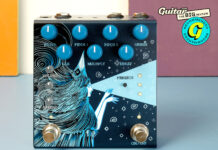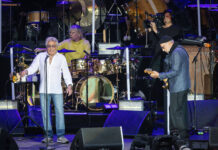
The untold story of Fender’s relic guitars
The notion of ageing, antiquing, or distressing an instrument has existed for decades. But the Relic wasn’t really a ‘thing’ until the Fender Custom Shop made it one. Prior to the introduction of the Relic Series in 1995, fake ageing and playing wear was applied to guitars either to help repairs made to valuable old instruments match the look of the rest of the original, or to create forgeries. You could say that Fender’s famed Relics came about as a merger of these two rather contrary concepts.
And as big as pre-aged guitars have become in the guitar world of today, it’s amazing to note that according to the two prime movers in the creation of Fender’s original Relics – JW Black and Vince Cunetto – the story of how it all came about has never been told fully, or accurately. Until now.
Some understanding of the founding of the Fender Custom Shop makes crucial back-story to the history of the Relic Series, but the venture was very much a thing unto itself in the beginning, and even owed a major part of its initial success to an outside contractor who was never an official Fender employee. One other significant mover in the venture, however, JW Black, was very much on the Fender payroll. Hired in 1989 by the head of the Custom Shop, John Page, Black had been a Master Builder for several years by the time the notion took hold in the early 90s that there might be some mileage in selling pre-aged guitars.
Vince Cunetto with some of the first bodies he aged for Fender back in the early days of the Custom Shop’s Relic programmeBlack learned guitar repair at a local shop in his home town of Bethlehem, Pennsylvania, before moving to Kansas City, Missouri, in 1980 to open a repair shop in the same building as famed vintage guitar dealer Jim Colclasure. In 1986, Black moved to New York City to work for Roger Sadowsky, and also moonlighted at Rudy’s Music, where John Suhr headed the repair and building side of the operation. And bit by bit along the way, Black’s path intersected with the notion of pre-aging a guitar.
“In 1982 Scott Baxendale showed me a 1952 Telecaster that he had refinished and aged the body to look era-correct,” he tells us. “Then in 1983 I converted a 50s Les Paul Junior to a ’59 Les Paul Standard by adding a maple cap, inlays, and painting it in faded, aged colour. And at Sadowdky’s Guitars in NYC in the late 80s we did aging on restorations.” All of which is to say, the concept wasn’t a new one as such, and had been there in the back of Black’s mind – and in use by other builders – when he arrived at the Custom Shop in 1989. Still, he had no call to put it into practice with Fender until a couple years later, when an artist requested that he do precisely that.
Was not Keef
“I saw Don Was at his studio on Mulholland Drive in LA when he was recording the Stones in the early 90s,” says Black, “And he said he was attending the Grammys. Bonnie Raitt was nominated and he was her producer, and they were going to perform. He had a new bass and wanted to know if we could ‘beat up’ or distress the instrument so it wouldn’t look like new sneakers on the playground.”
This flies in the face of a widely told apocryphal tale that Fender’s Relic Series was begun after Keith Richards tried a new Custom Shop guitar and liked it, but said he’d only play it if they “bashed it up a bit”. This is a total myth – one that has been thoroughly debunked by all parties involved in the founding of the Relic Series.
The fact that Don Was was recording the Stones when the idea first took hold at the Custom Shop is just coincidence. From there, the Custom Shop occasionally applied a little ageing treatment as a one-off for artists who needed that look, but it wouldn’t be a standard line until Vince Cunetto came into the picture.
Cunetto was able to accurately recreate the classic Custom Colour finishes before Fender worked with DuPont to colour match the original vintage huesCunetto describes himself as having been, “One of those kids who always liked to take things apart,” and although he had never worked full time as a guitar maker – he was in fact well employed in the broadcast side of the advertising industry when he and JW Black first bumped into each other – he’d already had a long and deep passion for creating vintage-style electric guitars by the time the seeds of Fender’s Relic project were planted.
“I started trading, buying and selling vintage guitars on the side in about 1984 or ’85 – I was living in Kansas City, Missouri, at the time,” Cunetto tells us, “And Jim Colclasure [vintage guitar dealer and former associate of JW Black] and I became friends. I got hit with the bug to have a vintage Telecaster of my own, but I couldn’t afford any of the ones I was trading myself, so I started farting around with trying to age guitars in the mid-80s – doing a lot of research into Teles and blueprinting them.”
JW Black (left) and fellow former Master Builder John Page with some of their early Fender Custom Shop creations. Black holds Nocaster Relic serial #10 and Page has Stratocaster Relic serial number 100“I’d borrow Telecasters from Jim and I’d machine pin-router templates, and I’d buy the wood and I’d take it to a company that had a nice old pin-routing machine, and I started making Tele bodies. Then I started finishing them. When I was a kid I had worked in this body shop, and that’s how I learned to spray lacquer.”
Meeting of minds
The two prime movers in our Relic story first came together when Colclasure introduced Cunetto to Black during one of the latter’s visits to his old stomping grounds in Kansas City. “Jim brought J to my house – I’d been making vintage Tele pickguards, and whole Telecasters and all this obsessive stuff,” recalls Cunetto.
“J said, ‘Wow, that’s cool! What are you doing here?’ So we got to know each other, and we stayed in touch.” To make his replicas complete, however, Cunetto needed the name on the headstock, and with his experience in the advertising world and inside connections to the art department, he knew how to get them.
“I figured out the process of duplicating decals from actual photographs, getting them scaled correctly, and making these really dead-nuts decals,” Cunneto tells us. “So I was doing that and kind of selling them at guitar shows, and it got out that I was the guy making them. I was talking to J one time – after he started working for Fender – and he said, ‘So here’s the scoop: we know you’re the guy making these decals, and it’s not cool, but if you quit doing that and you make them for the Custom Shop the way you made them for everybody else, it will be cool!’”
This was Cunetto’s first foray into contract work for the Fender Custom Shop, making period-correct logo decals for one-offs and short runs, and he also supplied aged parts on occasion, such as a distressed Bakelite pickguard, which Black had used to restore Ron Wood’s vintage blackguard Telecaster. And that’s how it went for a time, in bits and pieces… until the vintage-replica master and the Master Builder jointly realized that they could apply this thinking to a much grander scheme.
“My recollection,” says Cunetto, “Is that it started off with that pickguard. And J was like, ‘Wow, that’s kind of cool. What if we did a whole guitar?’ And I was like, ‘Well, I’ve been doing them for a long time!’” They would need to get the idea past the powers that be at Fender and the Custom Shop, and they would need to assess the market interest for such guitars, but Cunetto felt that if people were buying distressed leather jackets and stonewashed jeans and antiqued furniture, why not distressed guitars?
Black recalls: “Vince sent John [Page] and I an aged 60s-style Strat in gold metallic finish. All the parts and finish on the guitar were aged and patina’d to look like an authentic vintage instrument. It was very convincing, and was on the cusp of being a counterfeit. We decided to use Vince to make a couple of prototypes for the [winter 1995] NAMM Show: a 1950s Nocaster in aged Butterscotch Blonde, and an aged ’57 Stratocaster in Two-tone Sunburst.” But, as Cunetto recalls being told by Black, Page insisted, “Don’t tell anybody! Do it under the radar, don’t tell anyone in Fender management, and we’ll keep it in the Custom Shop.”
Cloak and dagger
To facilitate the prototyping, Black shipped boxes of Fender bodies, necks and parts from California to Cunetto in Colorado, which Cunetto would finish and age and return.
At some point, Black and Page decided the Sunburst Strat wasn’t working, and opted to make it a pair of blondes, changing the ’57 prototype to a Mary Kaye with gold hardware. By December of 1994 Cunetto had completed “five or six” acceptable prototypes displaying different levels of wear. Black and Page selected one Nocaster and one Mary Kaye Strat, and Page made up steel stamps to emboss the word ‘Relic’ inside the bodies and the Custom Shop logo on the backs of the headstocks, “to prevent counterfeit or confusion in the public,” as Black puts it.
“By the time we did the NAMM samples,” says Cunetto, “we knew we were going to do it. We didn’t know how many we were going to sell or anything, but we just wanted a good sample of each one to show. We got those done, and John didn’t tell anybody about it in management and all.
He had two glass display cases made up with gold plaques, and all it said on it was ‘50s Relic Nocaster’ and ‘50s Relic Stratocaster’. And I showed up at the NAMM show, because J said, ‘You’re gonna’ want to be here for this!’ And we hung them up, and people were saying, ‘Wow, that’s really cool that you’re paying an homage to your history with these old guitars!’ And the reps were like, ‘Yeah, they’re new guitars. How many do you want?’ And that was it. That was it!”
Mike Lewis was head of Fender’s marketing department at the time, and both Black and Cunetto say he was very supportive of the venture. “He embraced it right away,” Cunetto adds. “He looked at [the Relics], and he was like, ‘Hell yeah, we’re going to do this! Who wouldn’t want to play this? You could take this guitar at any time on any stage and put it in somebody’s hand, and they’d say, ‘Yeah, I’ll play that!’”
The first two Relic prototypes that were exhibited at the Winter NAMM Show in 1995“We initially intend to do the guitars in-house,” Black recalls, “But also during this time we had the threat of no longer being able to spray lacquer at Fender due to EPA restrictions. This was prior to Fender moving and putting in a $5 million spray facility that included an afterburner that would be compliant with the regs – Fender is still spraying lacquer today.”
Cunetto adds: “I was supposed to go out there and just consult with them, and relay the techniques and so forth, but they just weren’t set up for it. They couldn’t shoot the kind of lacquer that I had, and ageing the hardware and all – they just didn’t have the people to do this. And they were like, ‘Well, we’ve already got 400 guitars on order! We can’t tell them no.’”
“I was living in Estes Park, Colorado, and there was no way to find a place to do it there. But my wife at the time, her family was from north of Springfield, Missouri, and I figured, ‘No one is going to be watching anything down there, and I can probably find some labour…’”
Aged to perfection
By about April of 1995 Cunetto had established a 2,000 square-foot facility in Springfield with spray booths and the necessary tools and work stations, and hired a small crew that he’d trained to do the work. Black shipped him boxes of Fender bodies, necks and parts, and they got to work.
The first batch of aged ‘kits’ for 20 guitars was on its way back to Fender on 27 June 1995, and it was off to the races. For the first year or so, Cunetto would receive huge shipping boxes with parts for 20 guitars, and his team would prep them – hand-sanding out the orbital-sander marks and so forth – paint and age the bodies and necks, age the parts, and on Friday, set them all out and match up and tag the ones that looked like they should go together.
The results were boxed as individual sets to ship back to California, where the Custom Shop would complete assembly, fret dress, final setup and testing. While some guitar dealers couldn’t be convinced of the Relics viability as a concept, others embraced them immediately.
“Many dealers just laughed at them,” Black recalls, “And some could not sell them in the beginning. I remember that Guitar Center in Dallas sent all their Relics to Guitar Center in Chicago – and they sold in Chicago, when they hadn’t sold in Dallas at the time.” But Mike Lewis had been correct in divining that artists would go for them, and the uptake by professional players really helped to sell the concept. Fender’s Artist Relations rep for Nashville, Bruce Bolen, supplied his artists with Relics, and the AR department in Corona, California, did the same.
Sales grew steadily, and the Relic Series was firmly established as a mainstream production line in the Custom Shop catalogue. In 1996, Cunetto put together a larger facility with bespoke work stations and three times the paint-spraying capacity as the original Springfield facility. Soon, he and his team were sending 40 sets of aged guitar parts to Fender per week, and new models were added to the initial two.
“We added Two-tone Sunburst/maple Strats, Three-tone Sunburst/rosewood Strats, and over time we added the Olympic White Strats and other Custom Colours,” Cunetto recalls.
“This was well before DuPont went back and matched the Fender colours. But I had, in the years before, all the classic paint numbers for those Custom Colours, so we were painting them with DuPont colours just like they did originally. We had every kind of Custom Colour there was! We did Jazz Basses, Fred Stuart and I did some Jazzmasters; we did all kinds of artist guitars. Mark Kendrick and I did two basses for Sting to replicate his old one. We did stuff for the Stones, for Clapton… we did everybody.”
Toward the end of the decade, however, several changes signalled the writing on the wall for the end of what would come to be known as the ‘Cunetto Era’ of Fender Relics. John Page left the Custom Shop in November of 1998 to become the first Executive Director of the Fender Museum of Music and the Arts, and Mike Eldred took over as manager of that upscale wing of the company.
Meanwhile, Fender had expanded its own facilities and secured its ability to spray nitrocellulose lacquer. The time was right to bring the Relic operation back in-house, as had really been intended from the start. Eldred informed Cunetto of the decision, and the team in Springfield, Missouri, phased out its work over the course of late 1998 and early 1999, transitioning the operation back to the Fender Custom Shop in Corona.
Since they were launched in 1995, the Custom Shop’s Relic guitars are always some of the most attention-grabbing instruments at any NAMM showSo, was it difficult for Cunetto to say goodbye to the work? “Well, yeah!” he laughs. “It was and it wasn’t. I was in the middle of a divorce anyway, so everything was kinda weird at the time. But, yeah, I had to close the shop and get rid of all the people, and that’s never any fun. But it’s not like I really thought it was going to last forever anyway. And that’s kinda the way we went into it. John and I never had a contract, we just shook hands and said, ‘Okay, let’s do it until we don’t.’ That’s the way it was.”
“I took a lot of risk, and it paid off. It was certainly one of the coolest experiences of my life. Think about it: here I am, some schlub working in the advertising industry, and I’m going home and working on old guitars, and I love doing this – thinking, ‘that would be the absolute coolest job in the world, to be making these things and get paid for it!’ And lo and behold, a year later, it happened! And not only did I get paid for it, I made good dough. Because we were paid a lot of money; we made a lot of guitars, and Fender saved a lot of money. It was win-win.”
Coming home
JW Black now lives and works in Oregon, where he specialises in repairs to vintage Fenders and other guitars, and also makes and sells his own F-style guitars. Vince Cunetto lives and works in the suburbs outside St Louis, Missouri. From around 2003 to the early 2010s he built his own Vinetto guitars, which included his original design, the Legato, and aged T-style and S-style guitars in his Artefact series.
The tone and playability of Fender’s Relic guitars means they’ve have become fixtures on stages and in studios all over the worldCunetto still builds the occasional Vinetto guitar, but has been slowed by what he calls “a weird auto-immune disease that was diagnosed five or six years ago.” Upon bringing the operation back home to Fender in California, Eldred refreshed the line-up, introducing the popular Time Machine Series, which presented 50s maple ’board and 60s rosewood ’board Telecasters and Stratocasters in three different levels of distress: Relic, Closet Classic (gently aged), and New Old Stock (or NOS, vintage-style, but non-aged).
This three-tiered series had a long and successful run – although the Relics always sold in the greatest numbers – and has further evolved in recent years. Around the late 2000s and early 2010s, some custom-orders and short-runs began to be aged to what was termed ‘Heavy Relic’ and ‘Ultra Relic’ condition, adding increasing levels of distress to the existing gradations.
In 2015, Mike Eldred departed the Custom Shop, to be replaced at the head of the operation by Mike Lewis, who further expanded the Time Machine offerings. They now included, ranked in levels of ageing from none to most: NOS, Closet Classic, Lush Closet Classic, Journeyman Relic, Relic, and Heavy Relic.
Many players and product reviewers alike agree that the current range of Fender Relic models includes some of the finest pre-distressed guitars the Custom Shop has ever produced, while the guitars of the ‘Cunetto Era’ remain highly prized, and now carry collector-grade prices on the used market.
Check out other essential guides here.
The post The untold story of Fender’s relic guitars appeared first on Guitar.com | All Things Guitar.
Source: www.guitar-bass.net













